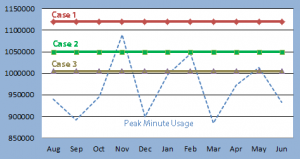MobilSense Optimization Tip #2
Optimization Tip #2: How to Construct a Minimum Cost Voice Pool
Of the major US wireless carriers, AT&T, Verizon and Sprint primarily incorporate a building block approach to constructing voice pools – a methodology that provides flexibility for pool resizing. Each plan contributes a small, fixed number of minutes towards the pool (200, 450, 900, etc.). On the other hand, T-Mobile utilizes single bulk minute values per pool (5,000, 10,000, etc.) with devices all included on zero minute add-on plans. This lends itself to less granular tuning of pool buffers.
Whether motivated by simplicity or by choosing an ‘everyone is equal’ cost allocation methodology, we most frequently find pools are comprised of a single standard minute tier – most commonly 450 minutes. Our experience is that companies with greater than 1000 devices typically average between 200 – 400 minutes/devices. The larger the device count the more likely the average migrates downwards towards 300 minutes/device or below. If you are lucky enough to have an AT&T or Sprint Business Essential Add On plan, you will have the most flexibility when reducing your pool size. Verizon and Sprint’s current pool families commonly provide 200 minute plans at the low end. All carriers offer larger minute options of 2000, 4000 or even 6000 and the more you can incorporate these high minute plans, the lower your total pool cost.
To illustrate the savings opportunity of incorporating high minute plans let’s look at scenarios where we have 3000 devices with an average usage of 375 minutes/device and a 20% buffer. We will do our calculations based on list price but the same economics will apply under your specific discounted rates.
In the table above all plan combinations end up with the same total number of pool minutes, 1,350,000. A 5% monthly savings can be generated by building your pool with a combination of high minute plans balanced with the lowest minute plan offered versus choosing to place everyone on the same plan. Using this approach of mixing plans may steer you towards a strategy we commonly use of pro-rating pool access charges based on pool minutes used.


